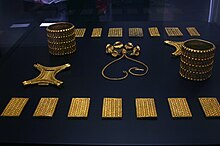Seville Archaeological Museum
The Seville Archaeological Museum (El Museo Arqueológico Provincial de Sevilla) is part of the museum ensemble in the Plaza de América about 2 km south of the old town of Seville . The story goes back to 1867 when it was founded by decree. The listed building was built in 1910 by Aníbal González in the neo-renaissance style for the purpose of exhibiting an Ibero-American collection there.
It contains, among other things, important finds of Punic settlements in Andalusia, which are referred to here as the culture of Tartessos , as well as the ancient city of Itálica , the birthplace of Emperor Hadrian . Visiting the museum is free for EU citizens.
exhibition
The museum is dedicated to the archaeological finds of Andalusia. The presentation distinguishes finds
- the Stone Age or Bronze Age
- the culture of Tartessos
- the Turdetaner
as well as finds
- of antiquity
- of late antiquity
- and the Middle Ages
Archaeological finds before the arrival of the Romans
This collection is in the basement of the museum. The centerpiece is the Carambolo treasure, discovered near Seville in 1958. It consists of numerous pieces of jewelry made of gold and a female figure. The inscription on this female statuette is written in the Punic language . It refers to the Phoenicians in general and the city of Thyros in particular. It is believed that the Tartessian culture was a colony of the Phoenicians who exploited the rich ore deposits of the Río Tinto . Inscriptions in the Tartessian language , which cannot be deciphered to this day, are an indication that the culture can be traced back to Phoenicians as well as to a local population. Since well-preserved finds of the Phoenician culture are very rare, the exhibition is of extraordinary cultural and historical importance.
Roman colony and Middle Ages
This part of the exhibition is located on the ground floor of the museum. Of central importance is the ancient city of Italica , the ruins of which are just a few kilometers north of Seville. It is the first city that was founded by the world power Rome on Spanish soil. The city gained prominence during the Roman Empire when one of their sons, Hadrian, was crowned emperor. The districts created during the imperial era are known as nova urbs / Neustadt. The old town, which was built in 206 BC. In contrast, it is called urbs vetus . The name refers to the veterans of the Punic War who settled there. While the ruins of Italica contain replicas of the original sculptures and mosaics, the originals are exhibited here in the Archaeological Museum of Seville. A venus sculpture from the urbs vetus is particularly impressive .
Web links
Individual evidence
- ↑ http://www.museosdeandalucia.es/cultura/museos/MASE/index.jsp?redirect=S2_2.jsp
- ↑ Monumento Histórico Artístico (según 1 de marzo de 1962, RI-51-0001402)
- ↑ http://www.museosdeandalucia.es/cultura/museos/MASE/
- ↑ Para la inscripción de la Astarté de El Carambolo (Sevilla): Tartesos y El Carambolo. Seville, 1992. Catálogo. Antonio Caballos Rufino y José Luis Escacena Carrasco, pág. 51.
Coordinates: 37 ° 22 ′ 16 ″ N , 5 ° 59 ′ 14 ″ W.


